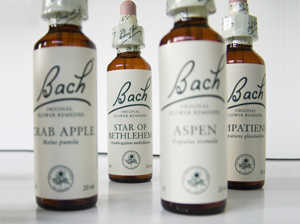
The flower essences have a clear beneficial effect on the psycho-intellectual state of man and can be a real help in psychological and psychosomatic problems. Still, it is particularly suitable for prophylaxis of the harmful effects of stress, in their various forms is manifested. The aim of the application is not running in the discharge of the problem, but extends to increasing living standards. The 38 flower remedies of Dr Bach, from flowers of various plants and can help in the restoration of emotional balance and restoring health. The flower essences have no side effects and can be used by everyone. Thus, the flower essences can help immensely in enhancing personality and become catalysts in a process of self-development and self-realization, depending on the desires and one’s life goals.

.
.
Bach flower remedies are an alternative or complementary treatment that is used for emotional problems and pain. They’re made out of watered-down extracts from the flowers of wild plants.
Edward Bach, a medical doctor and homeopath, created these remedies in the early 1900s. Homeopathy is the belief that the body can cure itself. It uses small amounts of natural substances like plants and minerals to treat the body or mind. The idea behind Bach flower remedies is similar to homeopathy. But they use fewer materials and don’t work directly on physical symptoms, but instead on the emotions.
Bach believed that healing negative emotions helps the body heal itself. His system contains 38 remedies that each address a specific negative emotion. The emotions are grouped into seven broad psychological causes of illness:
-
Fear
-
Uncertainty
-
Lack of interest in present circumstances
-
Loneliness
-
Oversensitivity to influences and ideas
-
Sadness or despair
-
Cares for others at the expense of self
The 38 remedies
A quick reference guide to each of the 38 remedies discovered by Dr Bach. Each remedy is directed at a particular characteristic or emotional state.
Agrimony – mental torture behind a cheerful face
Aspen – fear of unknown things
Beech – intolerance
Centaury – the inability to say ‘no’
Cerato – lack of trust in one’s own decisions
Cherry Plum – fear of the mind giving way
Chestnut Bud – failure to learn from mistakes
Chicory – selfish, possessive love
Clematis – dreaming of the future without working in the present
Crab Apple – the cleansing remedy, also for not liking something about ourselves
Elm – overwhelmed by responsibility
Gentian – discouragement after a setback
Gorse – hopelessness and despair
Heather – talkative self-concern and being self-centred
Holly – hatred, envy and jealousy
Honeysuckle – living in the past
Hornbeam – tiredness at the thought of doing something
Impatiens – impatience
Larch – lack of confidence
Mimulus – fear of known things
Mustard – deep gloom for no reason
Oak – the plodder who keeps going past the point of exhaustion
Olive – exhaustion following mental or physical effort
Pine – guilt
Red Chestnut – over-concern for the welfare of loved ones
Rock Rose – terror and fright
Rock Water – self-denial, rigidity and self-repression
Scleranthus – inability to choose between alternatives
Star of Bethlehem – shock
Sweet Chestnut – extreme mental anguish, when everything has been tried and there is no light left
Vervain – over-enthusiasm
Vine – dominance and inflexibility
Walnut – protection from change and unwanted influences
Water Violet – quiet self-reliance leading to isolation
White Chestnut – unwanted thoughts and mental arguments
Wild Oat – uncertainty over one’s direction in life
Wild Rose – drifting, resignation, apathy
Willow – self-pity and resentment
.
.
.

